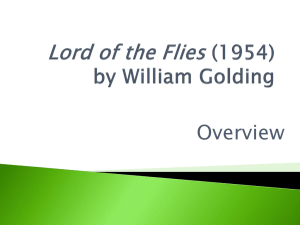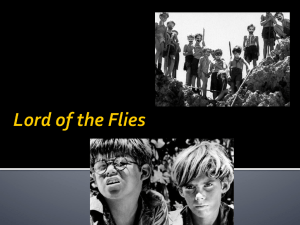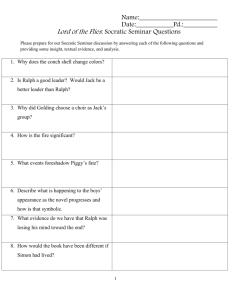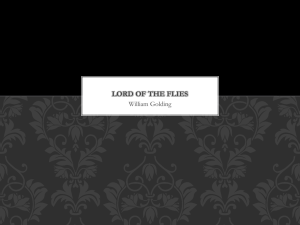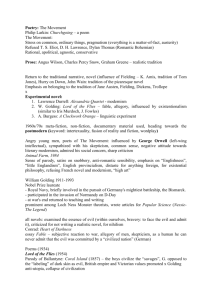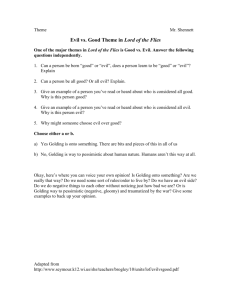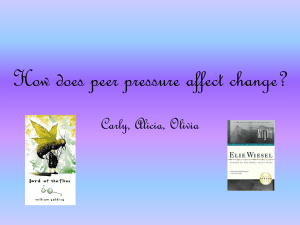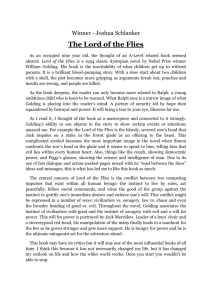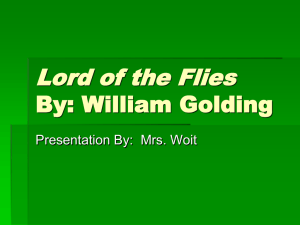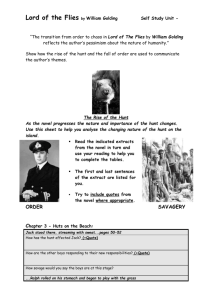LotF Themes revision guide.doc
advertisement
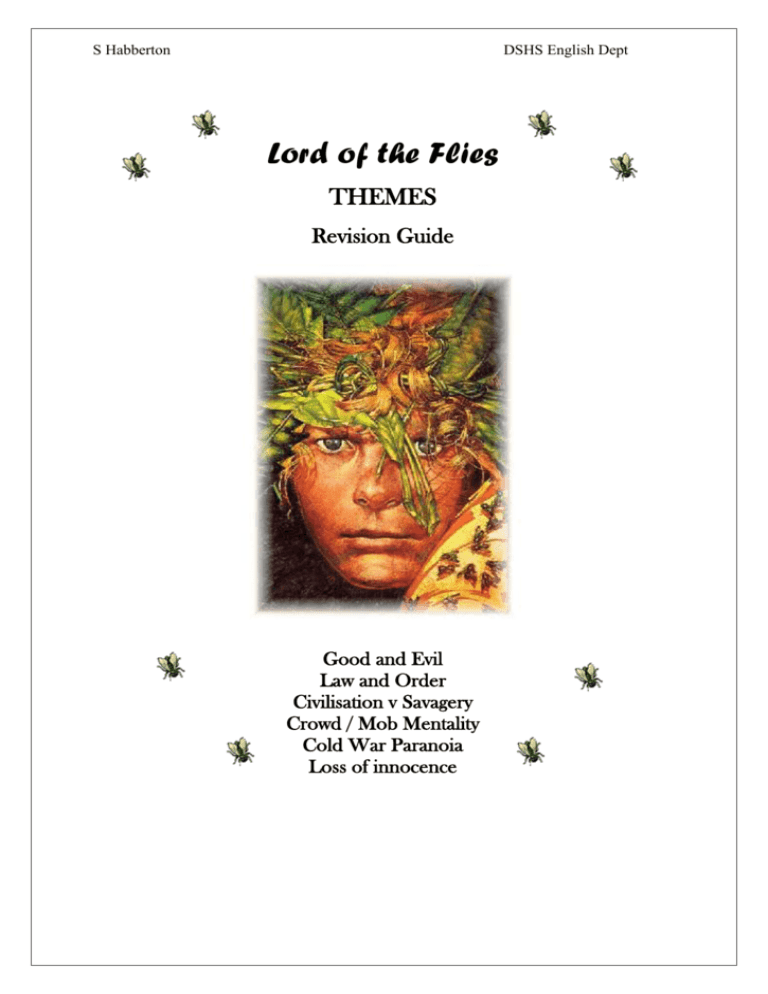
S Habberton DSHS English Dept Lord of the Flies THEMES Revision Guide Good and Evil Law and Order Civilisation v Savagery Crowd / Mob Mentality Cold War Paranoia Loss of innocence S Habberton DSHS English Dept What does Golding mean by the ‘Lord of the Flies’? One Potential theory Maybe he is saying that there is a beast, a ‘Lord of the Flies’ in all of us which is our potential for evil. This is controlled by our intellect and our sense of responsibility towards each other, what Jesus meant by ‘loving our neighbour’. Such a ‘beast’ causes football supporters to change into violent hooligans and it makes civilised countries commit appalling atrocities upon each other’s people; one only has to think of Bosnia or Iraq. It might also make two young boys kill a toddler, as in the James Bulger case. In all cases the action is self-destructive, and seems to take no thought to the outcome. People who act without thought for others or for the consequences of their actions are called SOCIOPATHS, and this is what the boys become. In their bloodlust for Ralph, the tribe destroy their home and their society. The island is therefore a microcosm, a small version of a bigger world. Another critic’s perspective This critic suggested that it might also be a macrocosm, a bigger version of the human character. “The symbolic encounter between Simon and the Lord of the lies represents the conflict between good and evil as it occurs in every man…Analyse any individual and you find in him Ralph’s tendency to adventure and common sense, Piggy’s intellectualism, Simon’s religious and poetic feelings, Roger’s willingness to torture, Jack’s appetite for destruction, Sam’n’Eric’s desire to please other people. How these different elements are oriented in the individual decides his moral outlook. But they are present as impulses in the human personality. Thus at the same time that this is a novel exploring the disintegration of a society, it is also the study of the identity of man.’ F. Jackson **************************************************************************** THEMES Taken at face value, ‘Lord of the Flies’ is a simple tale. Golding referred to it as a moral fable, which can be enjoyed on more complex levels. One way to appreciate this is to explore some of the themes of the book, to throw light on what Golding wanted to say and on the times he was writing in. This booklet contains information about key themes in ‘Lord of the Flies’, along with some background information. For each theme you must be able to make links to the text, and have a bank of quotations to draw upon. Knowing themes isn’t enough – you must also be able to analyse language, structure and character in light of those themes. S Habberton DSHS English Dept Civilisation V Savagery www.sparknotes.com The central concern of Lord of the Flies is the conflict between two competing impulses that exist within all human beings: the instinct to live by rules, act peacefully, follow moral commands, and value the good of the group against the instinct to gratify one’s immediate desires, act violently to obtain supremacy over others, and enforce one’s will. This conflict might be expressed in a number of ways: civilization vs. savagery, order vs. chaos, reason vs. impulse, law vs. anarchy, or the broader heading of good vs. evil. Throughout the novel, Golding associates the instinct of civilization with good and the instinct of savagery with evil. The conflict between the two instincts is the driving force of the novel, explored through the dissolution of the young English boys’ civilized, moral, disciplined behaviour as they accustom themselves to a wild, brutal, barbaric life in the jungle. Lord of the Flies is an allegorical novel, which means that Golding conveys many of his main ideas and themes through symbolic characters and objects. He represents the conflict between civilization and savagery in the conflict between the novel’s two main characters: Ralph, the protagonist, who represents order and leadership; and Jack, the antagonist, who represents savagery and the desire for power. As the novel progresses, Golding shows how different people feel the influences of the instincts of civilization and savagery to different degrees. Piggy, for instance, has no savage feelings, while Roger seems barely capable of comprehending the rules of civilization. Generally, however, Golding implies that the instinct of savagery is far more primal and fundamental to the human psyche than the instinct of civilization. Golding sees moral behaviour, in many cases, as something that civilization forces upon the individual rather than a natural expression of human individuality. When left to their own devices, Golding implies, people naturally revert to cruelty, savagery, and barbarism. This idea of innate human evil is central to Lord of the Flies, and finds expression in several important symbols, most notably the beast and the sow’s head on the stake. Among all the characters, only Simon seems to possess anything like a natural, innate goodness. *************** Loss of Innocence As the boys on the island progress from well behaved, orderly children longing for rescue to cruel, bloodthirsty hunters who have no desire to return to civilization, they naturally lose the sense of innocence that they possessed at the beginning of the novel. The painted savages in Chapter 12 who have hunted, tortured, and killed animals and human beings are a far cry from the guileless children swimming in the lagoon in Chapter 3. But Golding does not portray this loss of innocence as something that is done to the children; rather, it results naturally from their increasing openness to the innate evil and savagery that has always existed within them. Golding implies that civilization can mitigate but never wipe out the innate evil that exists within all human beings. The forest glade in which Simon sits in Chapter 3 symbolizes this loss of innocence. At first, it is a place of natural beauty and peace, but when Simon returns later in the novel, he discovers the bloody sow’s head impaled upon a stake in the middle of the clearing. The bloody offering to the beast has disrupted the paradise that existed before—a powerful symbol of innate human evil disrupting childhood innocence. S Habberton DSHS English Dept Good and Evil The battle between good and evil is a central theme of ‘Lord of the Flies’. It appears in many conflicts – between the conch group and the savages, between the boys and the terrifying ‘ beast’ and between rescue from a passing ship and imprisonment on the increasingly insane island, to name but a few. Early in the novel, good is in the ascendancy. The conch provides a symbol of the decency and order of the society that the boys have come from. Ralph organises the construction of shelters and a fire to signal ships with. The boys spend the majority of their time playing and there are few accidents. With Ralph’s benign government, good is always dominant. The situation is threatened as Jack continues his attempts to take over the conch group. He fails in this - a small victory for good – and sulks off to form his own ‘tribe’. From then on, evil takes control. Boys join Jack’s tribe because he hunts pigs and doesn’t make them work. Ralph, who represents the forces of good, is paralysed by indecision and has no effective response. Piggy’s glasses are violently stolen, leaving him sightless. When the remainder of the conch group goes to retrieve the spectacles, Sam and Eric are captured and Piggy slain. Only the naval officer’s intervention prevents the complete triumph of evil over good. Golding is giving us a warning about the power of evil, that if the good in people is not fostered then evil will take its place. The human urge to destroy will be unleashed and in the modern age there seems to be no limits to the harm this can do. In this sense, ‘Lord of the Flies’ can be seen as a cautionary tale, advocating change before it is too late (See Golding article and ‘Contemporary Relevance’ for more detailed information on this theme). ******************* Law and Order The boys have come from a society in which orderliness in the norm and they attempt to continue this when they first arrive on the island. Very quickly, the conch comes to symbolise values of this previous existence. The boys cannot talk at meetings unless they are holding the conch, and are thus forced to treat whoever is speaking with respect. This means that Piggy – in many ways a natural victim – is able to air intelligent thoughts that lead to improvements in the boys’ lives. So toilets are moved away from the shelters and the boys try to keep a fire burning at all times. The other symbol associated with piggy, his glasses, exposes a different side of law and order on the island. Rightfully they belong to Piggy, who needs them to see properly. Used with his permission, they also start the fires that are essential both to rescue and hygienically- cooked food. Jack – at school a figure of authority and order as head of the coir – refuses to respect Piggy’s right to the glasses, first punching him and breaking a lens, then stealing the pair to start fires. In doing so, he challenges the law and order that have kept life on the island reasonable under Ralph. When the boys no longer accept law and order after this, Ralph is powerless and darker, more evil forces take over. S Habberton DSHS English Dept Crowd Mentality At the start of the novel, we find a natural group already formed when Jack appears as the head of the choir. This group is disciplined, a fact which is of great help in hunting pigs, when good organisation is of paramount importance. As order on the island breaks down, the boys begin to behave differently in groups. Pig hunts become ritualised and frenzied, marked in chants like, ‘Kill the Pig! Cut her throat! Kill the pig! Bash her in!’ (Ch.4). The boys act as a mob at these times and start to lose their individual identities. This absolves them of any direct blame for what happens and distracts them from their plight on the island. The climax of the crowd mentality comes when Simon returns with news that the ‘beast’ is actually a dead parachutist. He stumbles into the midst of the near hysterical savages during a night-time thunderstorm, and is himself taken to be the beast. The mob, including Ralph, brutally murder him (Ch. 9). In a mob, everyday life loses its meaning. Individuals are swallowed up and the mob seeks out those who are weak or simply outsiders to vent its fury on. There have been pogroms – where mobs kill members of minority groups – throughout history. Foremost in Golding’s mind was Nazi Germany. Jack in many ways echoes Hitler. At first charismatic and seeming to offer easy solutions to difficult situations, both learnt to use the fury of the mob against their enemies. Hitler turned mobs against Communists, Jews, homosexuals, and indeed, many of his own followers to eliminate opponents and terrify everyone else. Jack likewise kills and intimidates until complete control in almost in his hands. See Ch. 12. ***************** Cold War Paranoia The first use of atomic weapons in war – at Hiroshima in Japan on 6 August 1945 – undermined many people’s assumptions about life. Suddenly it seemed possible for the whole of civilisation to be destroyed by a single conflict. This was not a practical problem until 1949, when the Soviet Union exploded its first A-bomb and the Cold War began. This was never an open war, although numerous conflicts, such as Korea, Vietnam and Afghanistan were fought in its name. It was an ideological battle in which anyone suspected of being the enemy would be attacked. Through the late Forties and early Fifties the infamous McCarthy witch-hunts were conducted in America. Many influential people were destroyed by (often false) allegations of Communism. This paranoia – imagining that good, patriotic citizens were traitors – is deeply reminiscent of Jack and of Hitler’s Germany. A great deal of the conflict in ‘Lord of the Flies’ stems from the Cold War outlook, e.g. Jack against Ralph, savages against the conch group, evil against good. The boys have been stranded by the Cold War turning into a real war. Their plane has presumably been shot down and the beast may be a pilot ejected from his warplane. Golding makes several points. First, that the worlds can be destroyed by atomic weapons. The island can be seem as a metaphor for the earth after a nuclear holocaust. Secondly, he is showing that the response to the Cold War – an hysterical and irrational desire to be on one side or the other, savage or conch – can only being a nuclear disaster closer. He suggests the way forwards is through individuals taking responsibility for themselves and not being manipulated by the mob mentality. S Habberton DSHS English Dept Revision Notes INSTRUCTIONS: For each of the key themes, jot down a brief explanation of meaning, then find three sections in the book to consider for each theme. Find quotations to support each section, and complete the table below. Use extra paper if required. Civilisation v Savagery Summary: Section in novel to consider Key Quotations Loss of Innocence Summary: Section in novel to consider Key Quotations S Habberton DSHS English Dept Good and Evil Summary: Section in novel to consider Key Quotations Law and Order Summary: Section in novel to consider Key Quotations S Habberton DSHS English Dept Crowd / Mob Mentality Summary: Section in novel to consider Key Quotations Cold War Paranoia Summary: Section in novel to consider Key Quotations
